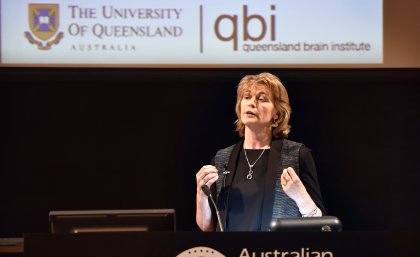
Researchers at The University of Queensland have contributed to the discovery of three new genes which increase the risk of motor neurone disease (MND), opening the door for targeted treatments.
Professor Naomi Wray from UQ’s Queensland Brain Institute was involved in the data analysis as a part of an international study of more than 30,000 people.
“These three new genes open new opportunities for research to understand a complex and debilitating disease which currently has no effective treatments,” Professor Wray said.
“Crucially, we hope Australian patients will be included in the next phase of the study, thanks to funds raised by the Ice Bucket Challenge.”
“We’re very hopeful that in the next phase of discovery, as sample sizes with measured DNA increase, that we’ll discover more genes associated with MND.”
More than 1400 Australians have MND (also known as ALS). Nerve cells controlling the muscles that enable us to move, speak, breathe and swallow begin to degenerate and die, and the average life expectancy is two to three years.
For more than 90 per cent of patients the diagnosis comes out of the blue – in what’s known as sporadic MND.
This latest research has increased the number of genes associated with the sporadic form of motor neurone disease from one to four.
The Motor Neurone Disease Research Institute Australia has funded the next phase of the research – the establishment of the Sporadic ALS Australia (SALSA) consortium which has implemented identical data and DNA collection protocols in all the major MND clinics in Australia.
“The consortium paves the way for Australians with MND to join the international efforts in genetic discoveries as a step towards penetrating the complexity of this terrible disease,” Professor Wray said.
This study is published in Nature Genetics.
MND FACT SHEET
- Motor Neurone Disease (MND) is known as amyotrophic lateral sclerosis (ALS) in many parts of the world, and also as Lou Gehrig's disease in the USA
- It is a group of diseases in which the nerve cells controlling the muscles that enable us to move, speak, breathe and swallow degenerate and die
- About 1,400 Australians have MND
- From diagnosis the average life expectancy is 2-3 years
- At least one Australian dies and another is diagnosed with MND every day
- The onset of MND can occur between the ages of 20 and 70, with the average age of onset being 59 years
- Most people experience motor problems in a single limb or area before the condition spreads throughout their body
- Motor function is controlled by the upper motor neurons in the brain that descend to the spinal cord; these neurons activate lower motor neurons. The lower motor neurons exit the spinal cord and directly activate muscles. With no nerves to activate them, muscles gradually weaken and waste
- The Ice Bucket Challenge was an international fundraising initiative which went viral on social media in 2014. Participants dumped buckets of ice water on their heads, to promote awareness of MND and encourage donations to research
- For more information about MND, or support, contact MND Australia on 02 9816 5322 or info@mndaust.asn.au
Media: Kirsten MacGregor, QBI Executive Communications Manager, k.macgregor@uq.edu.au, 0448 108 441.
.jpg)










